Are you looking to remove the studs from your winter tires to drive on them in the summer? It’s a quick and relatively inexpensive job at any tire shop, but you can take out the studs at home and save some money.
We’ll walk you through all you need to know about how to remove studs from tires, including the tools you’ll need for the job. Once you’ve done it, you’ll be relieved you didn’t spend money on getting your studs removed by a professional.
Here’s how to take out studs from your tires. It should take an hour or two. The total time you’ll spend depends on how tight the studs are and your experience with removing wheels and putting them back.
Car shops use a specific stud removal tool to take studs out with the least amount of force possible and without damaging the tire. If this is not something you’ll need in the future, though, save a little money and use a tool you already have around the house.
You can use either a small flathead screwdriver or needle-nose pliers. If you don’t have either of these, you can use a small knife, but you must be extra careful not to puncture the tires. It’s safer for first-timers to use a tool like pliers that lift the studs instead of digging them out.
Some people choose to work on their tires while they’re still on the car, but it makes the process unnecessarily complicated. It can also be more dangerous, and you would need to move the vehicle to reach the entire tire.
Taking off the wheel will give you more room to work and allow you a better grip on the studs. Use a jack to keep your car supported. Using a lug wrench, remove the wheel and support it on the ground.
Many people find the best position is to keep the wheel upright between their legs.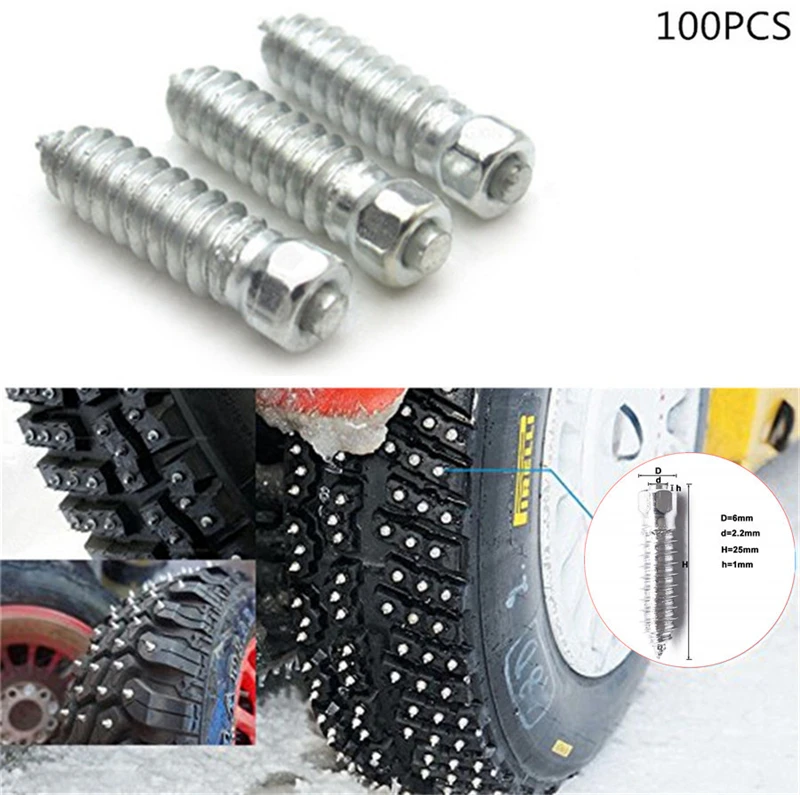 This way, you’ll have plenty of room, and you’ll be able to use your upper body strength.
This way, you’ll have plenty of room, and you’ll be able to use your upper body strength.
Putting some lubricant in the studs helps you loosen the rubber and get the tire studs out with less effort. You don’t need to buy anything at a store; a spray of soapy water on your tires will do, or apply some dish soap directly onto the tire, undiluted.
Avoid greasy lubricants and WD-40 since they can make your tires slippery on the road and put you in danger. They can stick to the rubber, making it hard to wash these chemicals out. These types of lubricants can also deteriorate the rubber of the tire over time.
Apply some lubricant directly on the tire and grab your tool of choice. This is how to proceed to take out the studs, depending on which option you’ve picked:
With pliers, grab the stud by the tip and lift it. A narrow pair of electrical pliers will be ideal for this job.
It’s possible that the stud won’t come out easily because the bottom is embedded inside the tread. In that case, you can try pushing the stud down before pulling, and twisting gently to loosen it up.
In that case, you can try pushing the stud down before pulling, and twisting gently to loosen it up.
A stud removal tool has a round tip designed to go around the stud to lift it off. To use it, you only need to place it on the tire and drive the tool gently under the stud. Then, twist it slightly and push to the side to pop the stud off.
Note that the studs are often surprisingly deep inside the rubber, especially on massive SUV and all-terrain tires. You must insert the tool quite deep while being careful not to harm the tread too much.
If you’re working with a screwdriver or small knife, insert the tip alongside the side of the stud until you get to the bottom. You should notice when you reach the edge of the stud. Then, turn the tool to a 45-degree angle to get it under the edge. Lift it carefully to pop the stud out.
This technique may take a bit of practice, but you’ll get it after a few tries.
Go around the tire before you put the wheel back on the car. Ensure there are no punctures or other damage to it, and that the air pressure is normal.
If you suspect punctures in the tire, you can check it. Spray some more of that soapy water you used as a lubricant directly on the tread. Apply some pressure and see if any bubbles are forming on the surface.
This check is harder to perform on truck and SUV tires because their tread blocks are deeper. In these cases, you also have the option to submerge the wheel in water as a simple way to test if any air comes out.
It’s time to put the wheel back on, move on to the next one and repeat the process. When you’ve finished, remember to secure the lug nuts properly.
You shouldn’t drive with studded tires in the summer.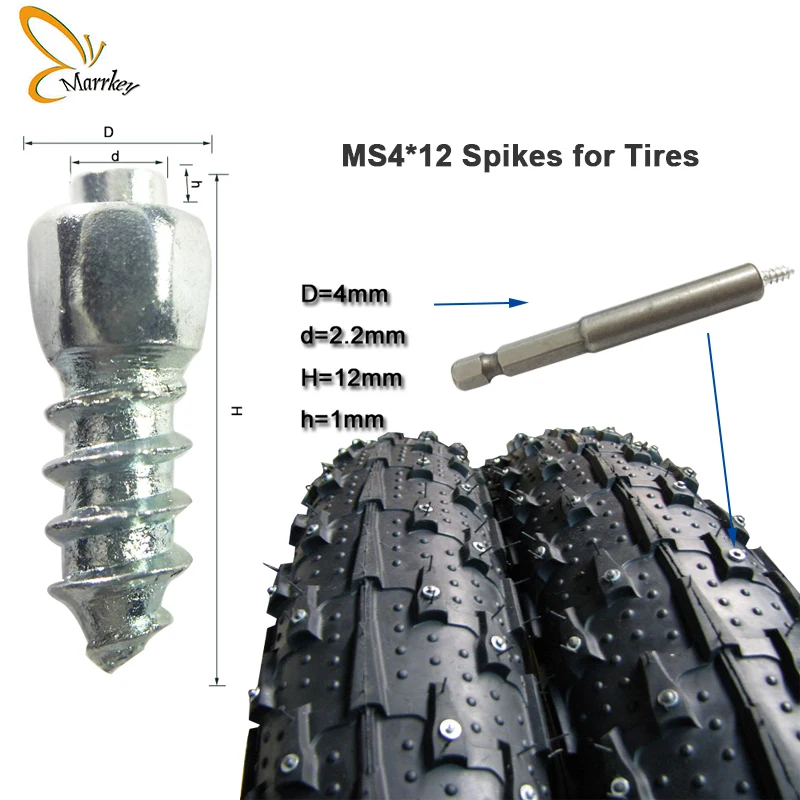 While they give you traction and improved grip on snow and ice, they’re not ideal for when the weather gets warmer.
While they give you traction and improved grip on snow and ice, they’re not ideal for when the weather gets warmer.
The rubber on winter tires is softer and maintains its elasticity even in low temperatures. They are too soft for the summer, though, and the tread will wear out faster when it’s warm.
Manufacturers design winter tires, studded or not, with large tread blocks for traction with sipes to keep them flexible. They also have deep channels to help water flow out. This makes them better for those rough conditions when you need extra grip.
Studded tires are noisy on the road, and using them all year round will impact your fuel-efficiency.
Also, the studs eat through the roads. This is why some states will not allow studded tires on their roads during the summer, or at all. Before you travel to a different state in your car, make sure its laws accept your tires on its highways.
Removing studs from tires is one of the cheaper things to get done at a tire shop because it’s such a straightforward process.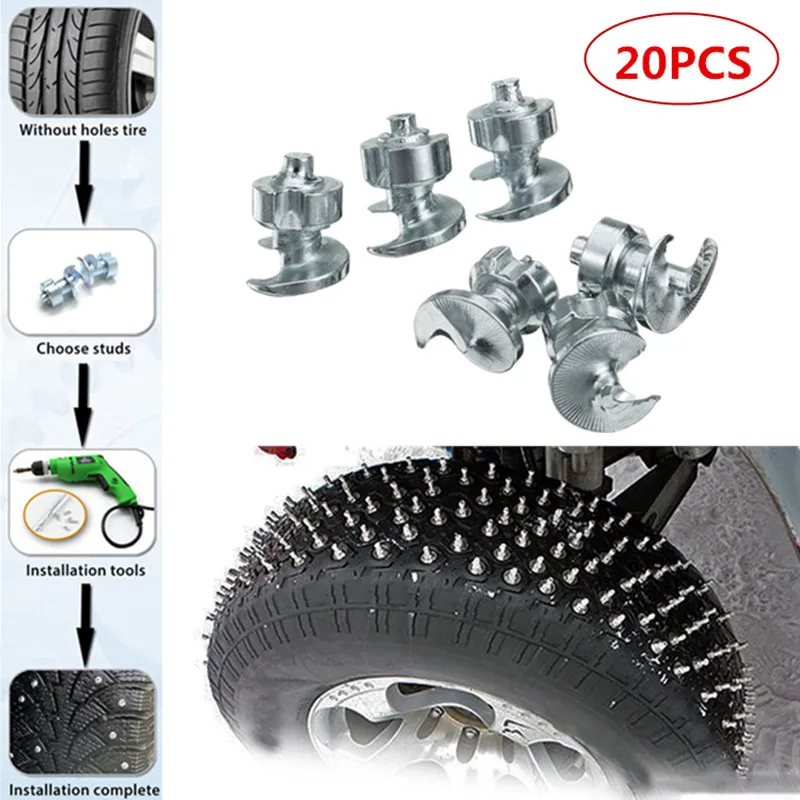 It shouldn’t cost you much more than $30 to $40 for an entire set of tires.
It shouldn’t cost you much more than $30 to $40 for an entire set of tires.
No, you should never try to replace the studs on a studded tire. It’s also best to get only new tires studded to ensure their safety. The studs will adhere to the tire best when the rubber is fresh, and there’s no debris on it.
Tires lose air pressure when the temperature drops in the winter because air packs into a smaller space when it cools down. It doesn’t mean your tires are losing air and is usually nothing to worry about, but you may want to pump some more air into the tires in the winter.
Depending on the specific conditions you’re driving in, the studs on your tires should last about 20,000 to 30,000 miles. Top tire brands may have studded tires that last double this time. When the studs are worn, check the tread to make sure it’s still deep enough to be safe to drive on after removing the studs.
Yes, studded snow tires result in fewer miles out of a full tank. This is why, if you live in a state with winter weather, having two sets of wheels is actually a money-saving option. You’ll get more out of your gas and your tires by using the weather-appropriate set for each season.
Usually, a studded snow tire will have around 60 to 120 studs. They’re placed in two rows along the shoulder blocks of the tire. The exact amount of studs depends on the tire manufacturer and model, so you’ll have to check your tires to know exactly how much work is waiting for you.
Yes, it is fine to remove studs from tires to use them in warmer weather. However, don’t try to restud them or use the tire when the tread is too worn.
So, you’re all set to go to work and get those snow tires ready for summer roads. Grab a stud removal tool, some pliers or a screwdriver, and don’t forget to use some soap as a lubricant to loosen up your tire studs.
Grab a stud removal tool, some pliers or a screwdriver, and don’t forget to use some soap as a lubricant to loosen up your tire studs.
Learning how to remove studs from tires is relatively easy and doesn’t take much time. You’ll get the hang of it after your first couple of studs.
Remember that you should only stud new tires, and that it’s not safe to stud your tires again after removing the studs.
When it comes to winter driving, having studded tires are a must. However, at the end of the season, it’s important to remove the studs from your tires so that you can use them again in the future. In this blog post, we will show you how to remove studs from tires quickly and easily.
To remove the studs from your tires, you will need a stud removal tool. You can purchase one of these tools online or at your local hardware store. In most cases, you will simply need to insert the tool into the tire and then twist it in order to remove the studs.
Once you have removed all of the studs from your tires, it’s important to inspect them for damage. If any of the studs are damaged, you will need to replace them before using them again. You can purchase replacement studs online or at your local hardware store.
Since we now know how to remove studs from tires, let’s t talk about why we need them in the first place. Studded tires are necessary for driving in winter conditions on icy or snowy roads.
The metal studs embedded in the tire tread provide extra traction and grip, which helps to prevent slipping and sliding.
In case you need to add studs to your tires, it’s a relatively simple process. You’ll need to purchase a studding kit, which usually includes a drill bit and the metal studs themselves. Most kits will also come with instructions on how to properly install the studs.
Once you have your kit, simply follow the directions and drill the studs into the tire tread. Be sure to not drill too deeply, as this could damage the tire.
Be sure to not drill too deeply, as this could damage the tire.
However, you can also get the service from a professional if you’re not comfortable doing it yourself.
The cost of studding a tire will vary depending on the type and size of the tire, as well as the number of studs you need to add. It’s generally not a very expensive process, but it’s always best to consult with a professional before attempting it yourself.
Averagely it costs between $25 and $50 to have a tire studded. This can obviously increase if you need multiple tires done, or if you encounter any problems during the process.
Yes, if you live in an area with heavy snowfall and icy conditions, it’s a good idea to stud your winter tires. This will provide you with the extra traction and grip you need to safely navigate winter roads.
If you’re not sure whether or not to stud your tires, consult with a local tire professional. They’ll be able to advise you on the best course of action for your specific situation.
They’ll be able to advise you on the best course of action for your specific situation.
Studded tires are a great way to improve traction and grip in winter driving conditions. However, it’s important to remove the studs at the end of the season so that you can use them again next year.
The short answer is yes, studs can be removed from tires. However, the process is not as simple as just taking them out. In order to remove the studs, you’ll need to use a special tool and follow a few steps. Keep reading to learn how to remove studs from tires.
First, you’ll need to find the right tool for the job. A stud removal tool is usually a small, handheld device that has a sharp point on one end. Once you have the tool, locate the studs in your tires. You may need to use a flashlight to help you see them.
Next, position the tip of the stud removal tool over the stud. Apply pressure to the tool and push it through the stud. You may need to wiggle the tool a bit to get it started.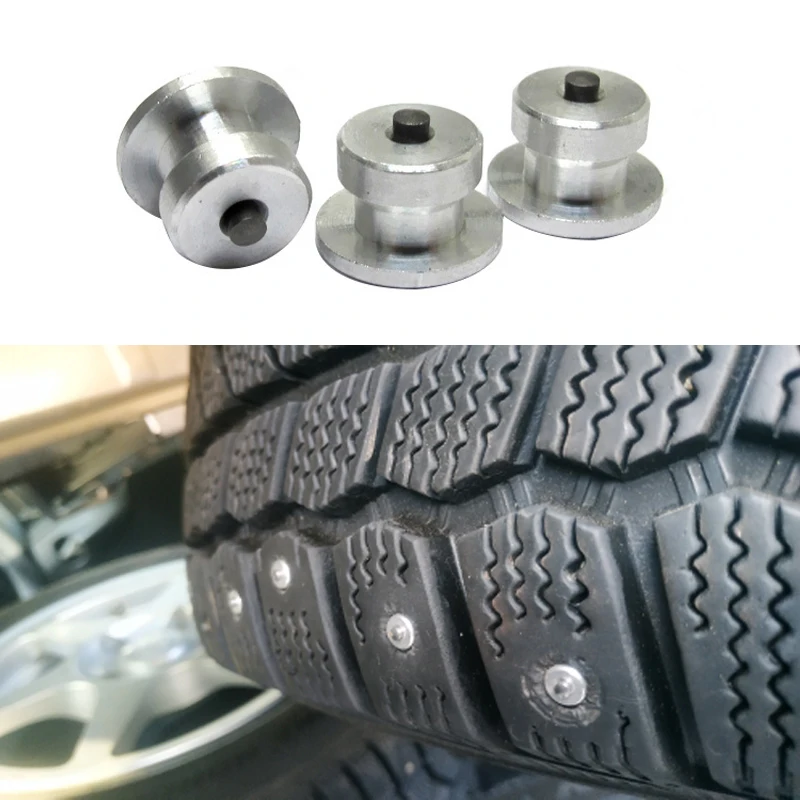 As you push the tool through, the stud will be forced out of the tire.
As you push the tool through, the stud will be forced out of the tire.
Once all of the studs have been removed, you’ll need to patch up the holes left behind. You can do this by using a tire repair kit or by taking the tire to a professional.
Now that you know how to remove studs from tires, you may be wondering if you can still drive them in the summer. The answer is yes, but there are a few things you should keep in mind.
Studded tires tend to wear down faster than regular tires. This means that you’ll need to replace them more often.
Second, studded tires are not as effective in the summer heat. This is because the studs can actually melt and become embedded in the pavement.
Studded tires also cause more road noise during the summer months. If you’re looking for a quieter ride, you may want to consider switching to regular tires.
When you decide to drive with studded tires in the summer, be sure to keep an eye on your tires and check them often for wear and tear. You may also want to consider using a tire cover to help protect your tires from the heat.
You may also want to consider using a tire cover to help protect your tires from the heat.
The cost of stud removal can vary depending on the type of tire and the number of studs that need to be removed. Generally, you can expect to pay between $50 and $100 per tire depending on a lot of factors. If you have a lot of studs in your tires, it may be more expensive.
No, you cannot replace studs in a studded tire. Once the studs have been removed, they cannot be replaced. This is because the holes left behind by the studs are too big to be filled with anything else.
Moreover, drilling new holes in a studded tire is not recommended. This is because it can weaken the tire and make it more likely to fail.
Studded tires typically last between 20,000 and 30,000 miles. However, this can vary depending on the type of tire and how well it is made. If you take good care of your studded tires, they may last longer.
If you take good care of your studded tires, they may last longer.
Studded tires are not banned in all states. However, there are some states that have restrictions on when and where you can use them. Be sure to check the laws in your state before driving with studded tires.
The number of studs on a tire can vary. Most tires have between 40 and 60 studs, but some may have more or less.
If you live in an area that gets a lot of snow, you may be wondering how to remove it from your studded tires. The best way to do this is to use a snow brush.
Start by clearing the snow from the top of the tire. Then, use the brush to remove the snow from between the studs. Be sure to work slowly and carefully so you don’t damage the tires.
Most people remove their studs when the weather starts to warm up. However, you may want to keep them on longer if you live in an area that gets a lot of snow. Be sure to check your tires often and remove the studs when they start to wear down.
However, you may want to keep them on longer if you live in an area that gets a lot of snow. Be sure to check your tires often and remove the studs when they start to wear down.
Removing studs is a simple process that mainly involves the use of a stud remover tool. You can purchase this tool at most auto parts stores.
Be sure to follow the instructions carefully and remove the studs when they start to wear down. However, you can also get services of a professional to do this for you.
Keep in mind that studded tires tend to wear down faster than regular tires and they also cause more road noise. If you’re looking for a quieter ride, you may want to consider switching to regular tires.
When you decide to drive with studded tires in the summer, be sure to keep an eye on your tires and check them often for wear and tear. You may also want to consider using a tire cover to help protect your tires from the heat.
You may find other related articles here:
Can You Drive With Snow Tires Above 50 Degrees?
How to Get a Stripped Lug Nut Off a Tire?
Tire Won’t Come Off: Here’s What To Do
A large number of car enthusiasts like to save on spare parts for their car. This is especially clear among Russian motorists. Recently, cases of intentional damage to winter sets of rubber have become more frequent, namely, depriving them of spikes. What is it for? To prevent drivers from buying a new kit for the summer season.
This is especially clear among Russian motorists. Recently, cases of intentional damage to winter sets of rubber have become more frequent, namely, depriving them of spikes. What is it for? To prevent drivers from buying a new kit for the summer season.
Therefore, you have to go to extreme measures and pull out the spikes yourself. Such an operation already has several ways to implement it. Let's take a closer look at each of them.
Contents
As they say, the first pancake always comes out lumpy. One of the very first ways to remove the spikes from their tires is with a screwdriver. This is done quite simply - we hook the spike by the upper part and make a sharp upward movement with the brush.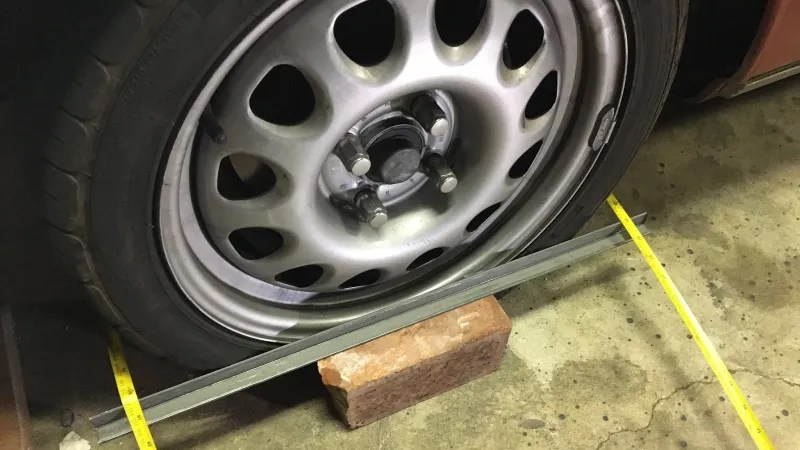
One such movement may not be enough, so the procedure must be carried out until the spike is removed. This is the worst way to extract spikes, as it is inefficient and traumatic.
Using this method, drivers will easily rub themselves huge blisters even at the stage of pulling out the third or fifth stud, and as you know, one tire contains about 80-100 studs. In other words, while the driver picks the tires with a screwdriver, a huge amount of time will pass, and at best 50 spikes will be removed in the end.
This type of studding is dangerous for the general condition of the tires, since it is likely to damage the rubber. When pulling out the spikes with a screwdriver, you must use the tool very carefully, and after the operation is completed and all the spikes are removed, you will need to check the tires for holes.
This is easy to do - just put the tires in water and see if there are any bubbles. If they go, then the tire is damaged and the air pressure in it will gradually decrease during movement. Otherwise the tires will be usable.
Otherwise the tires will be usable.
This method, unlike the previous one, is the most reliable and safe, but at the same time unprofitable financially. This is the only paid way to extract spikes from all possible ones.
Car service specialists have special equipment for removing studs. If you look at the rubber studding technology, you can see that the craftsmen use a special gun. A spike is inserted into this pistol, it is directed to a certain place where it will be inserted, the handle is pressed, and the spike is in place.
Reverse action tool available for pinning. But for this, it is first necessary to prepare the place where the spike is located, to expand the hole into which it is inserted. After that, you can already engage in its extraction.
If you use the help of third-party car repair shops and tire fitting companies, you can guarantee yourself complete safety when driving, since the tools used in such companies a priori cannot damage rubber. In the same place, the mechanics will immediately balance the wheels, which will be very appropriate after the wheel destudding operation.
In the same place, the mechanics will immediately balance the wheels, which will be very appropriate after the wheel destudding operation.
But the only stumbling block here is the financial side of the issue. Such a procedure is not so expensive, but who wants to spend money on something that can be done with your own hands?
It's hard to believe, but many drivers use this method to unclip winter tires. The effectiveness of this method is average - with sudden braking and making sharp turns, the spikes really fly out of their mounts on their own.
To do this, it is enough to skillfully use the high-speed mode and choose the right trajectories of movement. However, this method also poses a danger to the quality of the rubber, since along with the studs that have flown out, a serious level of rubber wear can also be obtained.
Many drivers try to keep the quality of tires as high as possible, but with this method of de-studding it is virtually impossible. In order to remove the spike from the surface of the tire, it takes quite a lot of time, during which you need to go a long distance. In the end, this will also hit your wallet, because you have to spend money on gas.
In order to remove the spike from the surface of the tire, it takes quite a lot of time, during which you need to go a long distance. In the end, this will also hit your wallet, because you have to spend money on gas.
Plus, when using this method, it is impossible to guarantee the complete removal of studs - in any case, there will be several dozen of them on all four wheels, which then will have to be removed also manually. Therefore, we do not recommend using this method, as well as the first one.
Studs installed in winter tires usually look like thick and short nails with a flat bottom and a flat head. They also have a tungsten pin on top. They are inserted with a flat head down, exactly into those holes that were distributed on the tread surface in advance during the manufacture of the tire itself.
Appearance of the spikes
How does the insertion take place? The extended fingers of the pneumatic action gun are inserted into pre-prepared holes, then they insert the studs into them and are removed.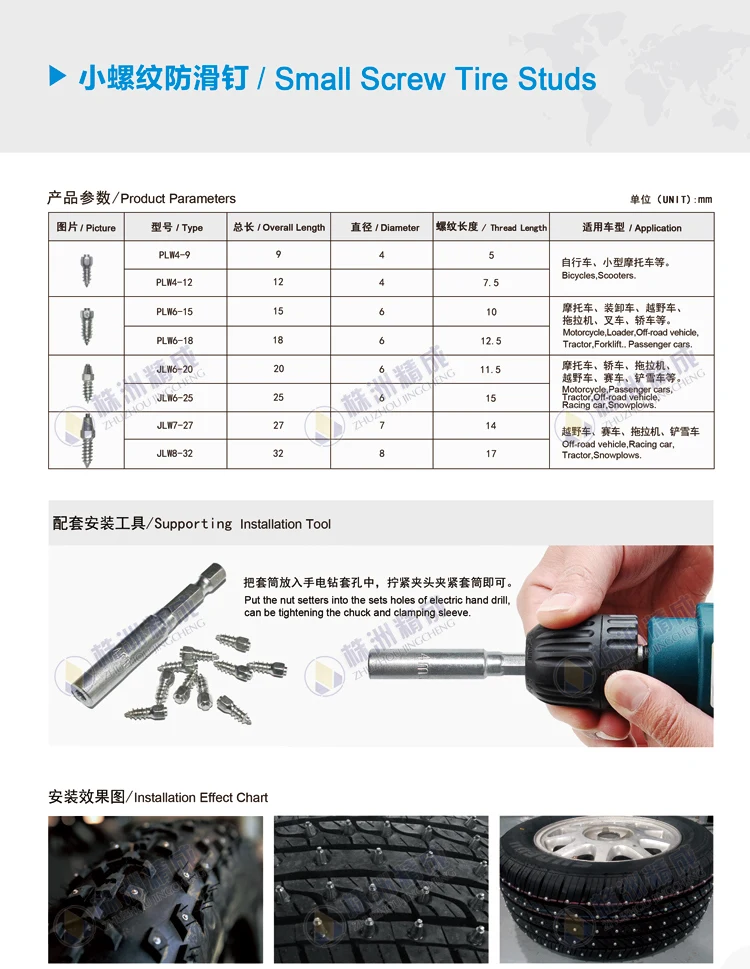 Such actions allow the tread rubber to return to its original state, as well as shrink around the stud cavity. In this process, the spike is securely held in the surface of the rubber. Recall that, depending on the tread pattern and tire size, each of them contains about 70-100 spikes.
Such actions allow the tread rubber to return to its original state, as well as shrink around the stud cavity. In this process, the spike is securely held in the surface of the rubber. Recall that, depending on the tread pattern and tire size, each of them contains about 70-100 spikes.
In order to remove the studs in the fastest and most effective way, you will need the most common pliers and a special lubricant that was previously used when fastening tires.
The principle of operation for such an operation is as follows - it is necessary to lubricate the studs with this lubricant, while the tires are well inflated before reaching the optimum pressure, then it is necessary to grab the stud with pliers by the upper surface and pull it up. In this case, it is imperative to ensure that the spike comes out of the rubber surface straight up, otherwise damage to the rubber may occur during operation.
Lubrication is required to ensure that the stud slides well when it is removed from the hole.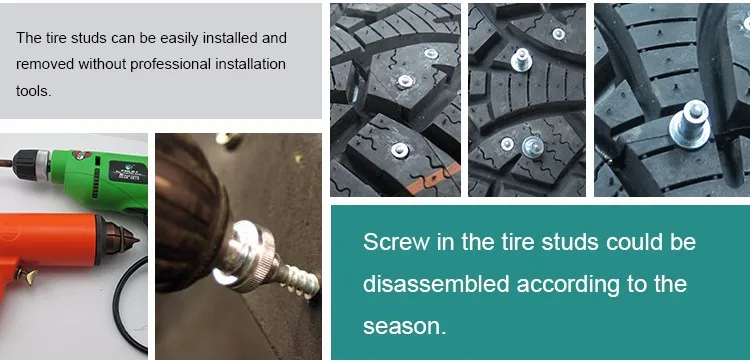 During de-studding, it is also necessary to pay attention to what is the residual depth of the tread. If this value is slightly more than 5 millimeters, then such an operation is the most optimal measure for the removal of spikes. In this case, you can guarantee that the de-studding will be done quickly and with the highest quality.
During de-studding, it is also necessary to pay attention to what is the residual depth of the tread. If this value is slightly more than 5 millimeters, then such an operation is the most optimal measure for the removal of spikes. In this case, you can guarantee that the de-studding will be done quickly and with the highest quality.
If the residual tread depth is less than 5.5 millimeters, then such an operation also takes place, but it must be done with extreme caution.
Before you start removing the studs from winter tires, it is best to watch videos containing a detailed description of this process, and these videos will describe exactly the last method of removing studs from winter tires.
On these videos, the masters clearly show the removal technique, they also advise the best lubricant for processing spikes. Also, if possible, it is better to use the video directly during deshipping. Thus, you can most accurately understand this process and repeat all the necessary manipulations.
Also, if possible, it is better to use the video directly during deshipping. Thus, you can most accurately understand this process and repeat all the necessary manipulations.
First of all, pay attention to how exactly the tenon is captured, since this is the most important element when de-pinning. Remember also that you should not overdo it with lubrication, otherwise it may make it difficult to pull out the spikes. Try to do everything exactly as the mechanics in the video do it - and then you can guarantee success in the planned operation!
Ultimately, I would like to summarize the following - in order to make summer tires out of winter tires, you need to have pliers and grease on hand. You can also use gadgets to view a saw while working, which will describe in detail the technique for removing studs from winter tires.
When carrying out such work, pay attention to the fact that the rubber is not damaged, otherwise it can be completely damaged in this way. If you have a studded wheel on hand that you will no longer need later, then it is better to try to practice on it. Pull out a few studs, try it, and if everything works out well for you, then you can proceed to de-studding the main set of winter tires.
If you have a studded wheel on hand that you will no longer need later, then it is better to try to practice on it. Pull out a few studs, try it, and if everything works out well for you, then you can proceed to de-studding the main set of winter tires.
Also remember, the miser pays twice.
If you remove studs from winter tires incorrectly, then in the future you will still have to buy a new summer set to replace the damaged winter one.
Yes, wheel alignment, on the one hand, will save you money on buying new summer tires. But think also about the fact that if the studding is incorrect, re-studding the former winter tires can be a waste of time if it is really damaged.
Prepare well before you start pulling the spikes, study the videos in detail and boldly start working if you are sure of your success!
Stud price with installation for 1 stud
| Stud type | Price for 1 pc. |
| Single flange | UAH 3.00 |
| Double flanged | UAH 4.00 |
| Tri-flange | UAH 5.00 |
* Uses French and German studs.
Tire studding
| Service | Price for 1 pc. |
| Removing one stud | UAH 1.50 |
| Cleaning the tenon hole | UAH 1.50 |
| Dowel hole cutting | UAH 1.50 |
Studded tires are needed to reduce slip and for better tire grip on the surface (this is especially true when driving on slippery roads - during ice or packed snow, for example).
Studs are usually installed on winter tires (sometimes off-season), which were originally designed for studs (they have large separate uncut checkers).
Studs are mainly used in two types: single flange and double flange. Single flange studs are suitable for moderate city driving. They are well adapted to medium loads. Double-flange studs are designed more for extreme driving, when the driver plans to develop high speeds on the tracks and at the same time not be afraid to get into an unpleasant accident due to sliding.
There is an opinion in the circles of car drivers that the durability and studs can only be guaranteed by factory studded tires.
Such beliefs are, of course, not unfounded - the factories usually adhere to strict studding standards, which are the result of many years of technological improvements, which guarantee good performance and resistance to stud wear for a very long time.
But, oddly enough, very few car enthusiasts know that rubber studding, carried out on modern professional equipment, can give the same characteristics and quality as studding made by craftsmen at the factory.
It is best to stud tires in specialized workshops. This guarantees factory comparable quality and also saves you time (the process itself is quite labor intensive and of course requires special equipment such as a special pneumatic studding gun). New, only studded tires must first be run in at a low speed (50-60 km / h), without sudden maneuvers and turns. You need to drive a couple of hundred kilometers. After that, you can already gradually increase the speed.
This guarantees factory comparable quality and also saves you time (the process itself is quite labor intensive and of course requires special equipment such as a special pneumatic studding gun). New, only studded tires must first be run in at a low speed (50-60 km / h), without sudden maneuvers and turns. You need to drive a couple of hundred kilometers. After that, you can already gradually increase the speed.
Driving with studded tires can be very uncomfortable at first. The car becomes noisier, requires more fuel. However, after a few days of driving there is a complete addiction and you again feel complete control over the car. In a porridge of snow and mud, or just in loose snow, the effect of the spikes is almost imperceptible. On a dry paved road, studded tires can even lose to regular tires - the braking distance increases by 7-10%. But on ice or in areas with rolled snow, the braking distance can be reduced by up to 70%, which is very good, especially if you have to visit such roads relatively often.